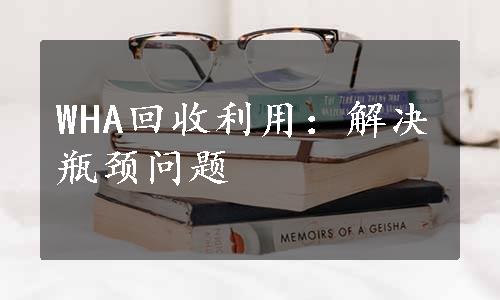
Electronic Waste Disposal
电子废弃物始得资源化
Recycling of Electronic Wastes
电子废弃物,尤其是废旧家电(简称WHA),由于具有数量庞大、环境问题严重、资源化价值显著等特点,已成为世界关注的热点,对其回收处理被视为21世纪充满活力的新型科技产业。进入本世纪,我国WHA数量迅猛增加,对其拆解利用规模不断扩大。资料显示,到2020年,我国WHA年产生量将达10 000万吨,约占全球总量的一半,回收处理产业发展潜力巨大。项目研发团队自2002年以来,针对我国WHA回收处理整体技术落后和管理水平不高的现状,开展技术研发与创新,通过对工艺技术、成套设备等科学研究、工程示范及产业发展,取得了显著的社会环境效益和经济效益。
Electronic waste, especially that from waste household appliances (WHA), with characteristics of huge quantity, serious environmental impacts and significant resource value, has continuously drawn attention in the world, and recycling of them is regarded as a new promising technological industry in 21st Century, which has seen a rapidly increasing of WHA recycling and re-utilization in China. Statistics show that by 2020, WHA production in China will reach 100 million tons, accounting for about half in the world, so that WHA recycling industry has great potential. Since 2002, a project team in Tongji University, aware of the status quo of outdated technology and immature management in WHA recycling business in China, has made research innovations that give birth to development of corresponding technology potential of significant social economic and environmental benefits in the way of developing scientific research equipment, demonstration projects.
废锂电池拆解分离与资源化
Dismantling, Separation and Utilization of Waste Lithium Batteries
开发了废锂电池湿法破壁拆解工艺,可消除电极间化学效应所产生的发热或燃烧隐患;研发的破碎筛分-静电分选、锤振-筛分及热分解工艺,可实现铜、铝、钴、锂等的高效分离回收;基于超声空化效应,研发了失效钴酸锂超声水热溶解-结晶技术,一步法实现了失效钴酸锂晶体结构修复和表面有机杂质的高效去除,修复后的钴酸锂电化学性能可达到再利用要求。
Wall-breaking of waste lithium batteries in wet processes could eliminate heating or combustion hazards generated by chemical effect between electrodes. Combined processes of crushing, screening, electrostatic separation, hammer vibration sieving and thermal decomposition can separate and recover copper, aluminum,cobalt, lithium effectively. Based on ultrasonic cavitation effect, the technology of ultrasonic hydrothermal dissolution and crystallization of failed lithium cobalt oxide was developed to achieve both the efficient removal of organic impurities and the renovation of lithium cobalt oxide crystal structure simultaneously. The renovated lithium cobalt oxide phase could reach electrochemical properties of commercial batteries.
钴酸锂晶体结构重整机理
Mechanism of crystal reforming of lithium cobalt oxide
废液晶显示器(LCD)及阴极射线管显示器(CRT)拆解分离与资源化
Dismantling, Separation and Utilization of Waste Liquid Crystal Display and Cathode Ray Tube
利用高温高压水的特性,研发了废液晶显示面板水热处理技术,在对液晶无害化降解的同时,可实现偏光片产有机酸资源化;利用CRT屏锥玻璃在可见-近红外具有完全不同的特征反射光谱,设计了CRT整体破碎料中屏玻璃和锥玻璃光谱连续自动分选系统;开发了以CRT屏玻璃和粉煤灰为基础原料制备泡沫玻璃建筑保温材料的技术工艺。
In high temperature and high pressure, waste LCD panel was treated into organic acids to be hydrothermally transformed in order to recycle organic materials. The continuous and automatic sorting system for screen glass and cone glass of broken CRT materials was designed based on different reflection characteristics of CRT glass in spectrum. Scrap CRT screen glass and coal ash were re-used as raw material to produce insulated foam glass designed for building thermal materials.
废印刷线路板组成材料拆解分离与资源化(www.xing528.com)
Dismantling, Separation and Utilization of Waste Printed Circuit Board
研究了线路板元器件拆解、破碎解离、分离富集处理工艺路线;利用金属与非金属间的密度差,开发了固体流态化气流输送分离装置与工艺,实现了废线路板中金属与非金属的高效分离,金属回收率达95%以上;开发的线路板非金属基材热解技术,可同时实现其中树脂有机物产油资源化与所含溴化阻燃剂的脱除无害化。
The process of dismantling, breaking, separating and enriching of the circuit board components is designed.In view of the density difference between the metal and nonmetal, the solid fluidization gas flow separation device and technology were developed, which can realize the efficient separation of metal and nonmetal in waste circuit board, and recover more than 95% of metals. The nonmetal substrate pyrolysis technology can transform organic resin into oil, and remove brominated flame retardants off waste printed circuit board.
WHA管理体系
WHA Management System
以上海市为对象,研究确定了WHA回收网点布局,对回收中转站进行了选址优化,采用蚁群算法优化确定了收运路径,构建了废旧家电收运网络;以B2C回收网站为基础,构建了复合型再生资源回收利用及现代物流综合网络服务平台和废家电在线回收系统。
Taking Shanghai as an example, the layout of WHA recycling outlets was studied. The recycling transfer station location was optimized. Ant colony algorithm was applied to optimize the transportation path. Waste household appliances transportation network was then built. On the basis of B2C recycling website, a complex recycling structure of renewable resources recycling, modern logistics integrated network service platform and online recycling system of waste household appliances was established.
该项目建成了单台处理能力2吨/小时的废印刷线路板分选系统和年生产能力达4 000吨的塑料粒子生产线,铜的回收率高达98%以上;建成了年处理能力110万台的废CRT拆解线,年处理能力12 000吨的CRT热爆分离系统和年处理能力达2 000吨的废LCD处理线,以及年处理量300吨的废锂电池资源化生产流水线,2005年至今累计实现经济效益5 542万元。
The project has completed a single processing capacity of 2 t/h waste printed circuit board sorting system and the annual production capacity of 4 000 tons of plastic particle production line. The recovery rate of copper is more than 98%. The project has also built a dismantling line of waste CRT with annual processing capacity of 1 100 thousand units, a CRT thermal explosive separation system with annual handling capacity of 12 000 tons,a processing line with annual capacity of 2 000 tons of waste LCD, and the lithium battery production line with annual processing capacity of 300 tons. Since 2005, 55.42 million RMB of economic benefits have been achieved.
该创新技术均属于资源与环境技术领域,符合我国循环经济及可持续发展的方向,不仅可以有效地缓解电子废弃物带来的日益严峻的环境污染问题,还可以节约有限的资源能源,将电子废弃物经过这些技术处理后,变废为宝,循环再利用,为环保事业做出贡献,以期带来显著的环保效益、社会效益和经济效益。
The innovative technology belongs to the field of resources and environment, which is in line with circular economy and sustainable development. These technologies can not only effectively alleviate increasingly serious environmental pollution caused by waste electronic and electrical equipment, but also save limited energy resources.Waste electronic and electrical equipment could be transformed into valuable materials and recycled with the help of these technologies, so as to contribute to the cause of environmental protection and bring significant environmental benefits, social benefits and economic benefits.
(同济大学等单位供稿,朱昊辰等整理)
(Contributed by Tongji University, sorted by Zhu Haochen)
免责声明:以上内容源自网络,版权归原作者所有,如有侵犯您的原创版权请告知,我们将尽快删除相关内容。




